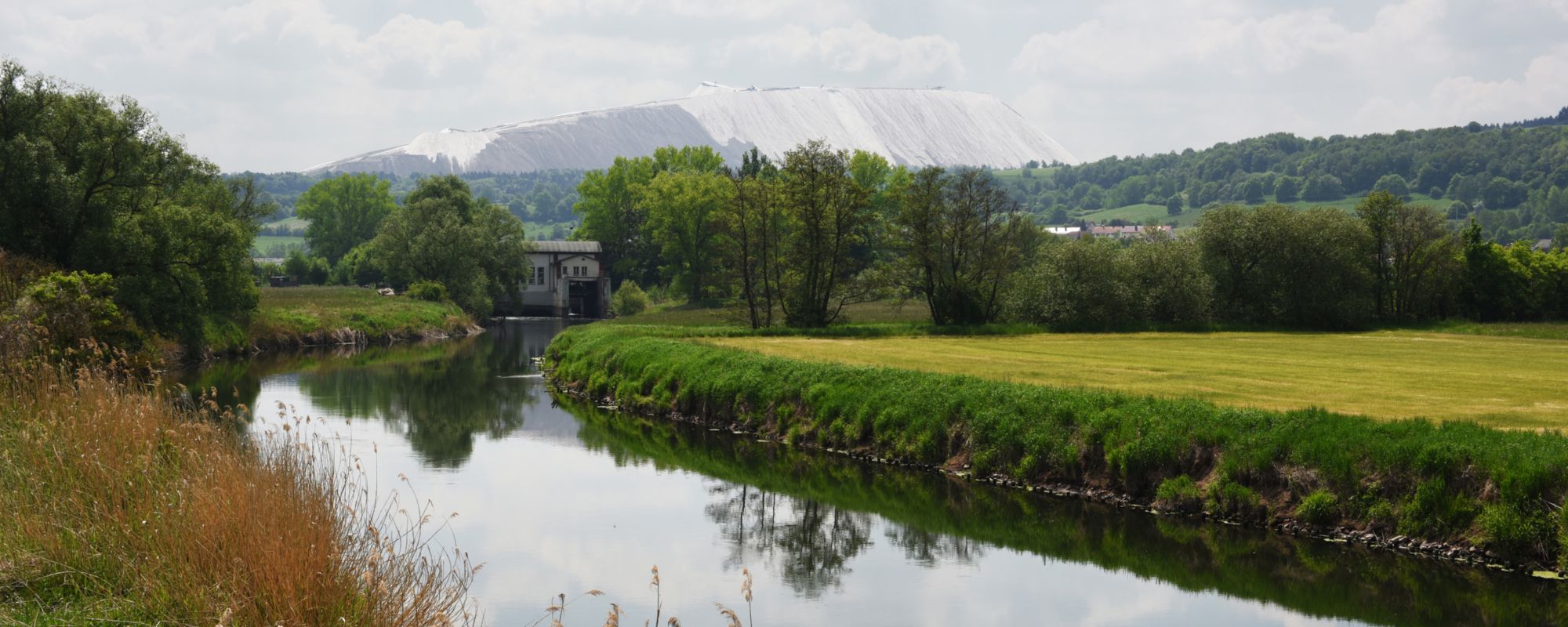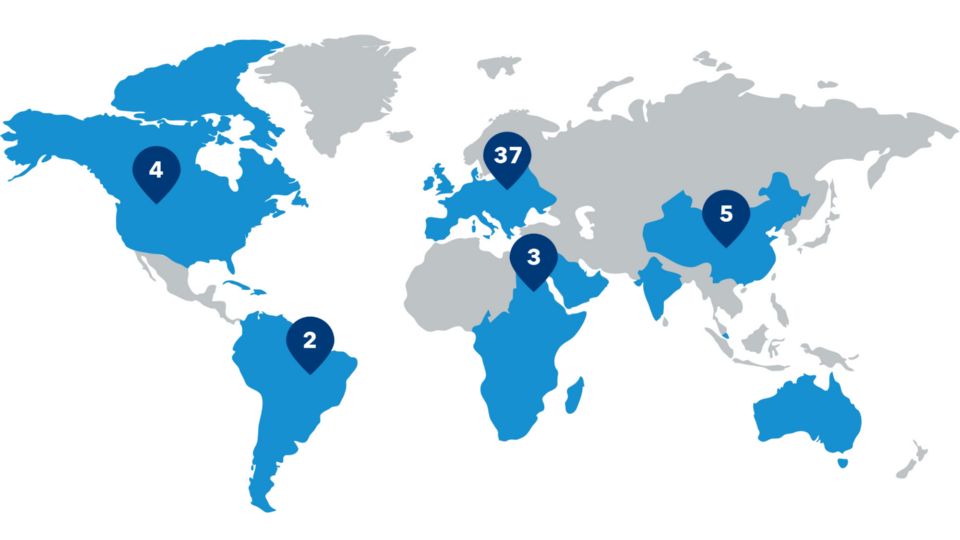Balancing economy and ecology
Value creation and environmental protection are not mutually exclusive. Like any raw material production, potash mining is also associated with unavoidable environmental impacts. We make great efforts and use state-of-the-art processes in order to keep the impact of production on the environment as minimal as possible.
Long-term disposal options

Our goal is to conserve resources, to extract and refine mineral resources in an innovative and efficient way and to further reduce the associated impact on the environment.
The disposal of residues from potash production is in line with the management objectives of the Weser river basin community (FGG) and the plan for reducing salt. The main cornerstones are:
- Stopping the injection of saline wastewater into the plate dolomite as of 2022
- Reducing the discharge of saline wastewater into the Werra by using underground disposal options (storage)
- Reducing the accumulation of tailings pile water by covering.
Constructive cooperation with FGG Weser
Together with the representatives of the Werra and Weser neighbors, we want to achieve a balance between environmental goals and economic requirements. In order to achieve this, we will continue to maintain a close and trust-based dialogue with the FGG Weser.
EU Commission praises water-protection measures
At the beginning of June 2019, the EU Commission discontinued infringement proceedings against the Federal Republic of Germany for non-compliance with the European Water Framework Directive (EU WFD).
This is an important step that in particular takes into account the measures that K+S has implemented to date and is continuing to plan for the continuous reduction of salt in the Werra and Weser rivers.
Ambitious water-protection goals
At the end of 2021, K+S will discontinue the underground injection of saline waste water in the Werra potash area. From 2028, no more highly mineralized process wastewater is to be discharged into the Werra and by 2030, the volume of saline wastewater is to be reduced again by 500,000 cubic meters per year.
Major projects implemented

Over the past decades, K+S has made enormous efforts to continuously reduce the amount of saline wastewater produced.
Since 2007, we have reduced the volume of saline wastewater at the Werra plant by a total of 60 percent. For the discharge of saline wastewater into the Werra and Weser, this means that the salt load was halved during this period.
Since 2011, K+S has invested more than EUR 500 million in state-of-the-art technical facilities and processes for this purpose. An example of this is the kainite crystallization and flotation plant (KKF) at the Hattorf site, which went into operation at the beginning of 2018. With the plant, additional valuable materials can be extracted from previously unusable salt solutions and, at the same time, the amount of wastewater from the Werra plant can be reduced by about 20 percent annually. With an investment volume of EUR 180 million, the KKF plant is the largest single water-protection project to date.
Water protection pays off

The positive effects can also be seen in the stabilization and increase in fish populations in the middle and lower Werra: around twelve species find suitable habitats and breeding conditions again in the river.
We take the concerns of local residents, citizens' initiatives and other stakeholders regarding the environmental impact of our potash production very seriously and are in close dialogue.
An important agreement in this connection was the settlement between K+S and the municipality of Gerstungen on various measures to improve the drinking water supply to the municipality in December 2017. Discussions with other interest groups, such as BUND, have already led to further agreements or are proceeding very constructively in order to achieve a reconciliation of interests.
We are becoming more robust against weather-related influences
A low water supply can lead to restrictions in the disposal of saline wastewater and therefore in potash production. In order to be better prepared for longer dry phases in the future, we have established the necessary interim storage facilities in order to be flexibly prepared for different situations. The aim is to avoid production stoppages due to disposal.

Following the approval of a temporary underground storage facility with a capacity of up to 400,000 m3 , we now have a storage and basin volume of 1 million m3 at the Werra site, for example, in order to temporarily store wastewater from tailings and production wastewater and to be able to discharge it again in compliance with existing limits if there is sufficient water supply.
In addition, we have optimized transport capacities for transporting salt water to Lower Saxony and Saxony-Anhalt by rail and truck. The measures we have taken reinforce our view that it is highly probable that production downtimes caused by wastewater at the Werra can be ruled out even in the event of prolonged drought.
Ambitious water-protection goals
The crude salt extracted underground in potash mining only contains a limited proportion of valuable substances of up to 30 percent. The remainder are residues that cannot be used economically and have to be disposed of - either in liquid or solid form.
Various disposal methods are used for these residues from potash production. In various combinations, they represent the most modern worldwide:
- Putting on tailing piles
- Using as backfill
- Discharging
- Injecting
- Using liquid residues as flooding medium
- Storing liquid residues underground
Most of the residues from potash production are put on tailings piles. Backfilling as well as discharging/injecting are also common disposal methods in the potash industry.
The world of white mountains

The locals call them Kalimandscharo or Monte Kali: these are the large tailings piles that are visible from a distance and that have been created by the accumulation of solid residues from potash production.
It is common practice all over the world to put the residues on tailings piles. The installation of sealed layers ensures that the tailings piles are technically sealed with regard to the infiltration of salt water. Special precautions are taken for the collection and disposal of tailings pile water caused by rain. The runoff is collected in ring ditches and drains and disposed of in accordance with the law.
The K+S Group's tailings piles are monitored extensively on an ongoing basis. In addition to groundwater and surface water monitoring, the monitoring also includes dust measurements.
Filling the cavities with backfill
The miner calls "backfill" residues that remain underground or are taken back underground to fill the cavities created during the extraction of raw materials. However, the possibilities of backfilling are limited by technical and mining factors, among others.
For example, the extraction of crude salt from the surrounding rock and the subsequent crushing for processing leads to a considerable increase in volume. This means that for physical reasons, too, the entire residue cannot be returned to the underground caverns. Complete backfilling is only possible at a few locations worldwide, for example if the geological structure and the associated mining process of a mine permit it. K+S does this at the Unterbreizbach site of the Werra plant.
No potash without saline wastewater

During the processing of crude salt into high-quality products such as fertilizers, saline wastewater is produced. These waters, as well as the wastewater generated by precipitation on the tailings piles, must be disposed of. Around the world, this is mainly done by discharging into rivers or oceans. In Germany, this is done in compliance with officially defined limits. K+S is permitted to discharge saline wastewater from the Werra plant into the Werra river in compliance with these limits.
At many potash sites worldwide, liquid residues are disposed of by injection into deeper layers of rock. K+S will discontinue this type of disposal at the end of 2021.
Bringing salt back
We see a promising way for the environmentally friendly and safe disposal of saline wastewater in the future. By storing it underground. This means that salt water is pumped into the caverns of an underground mine that are no longer used. K+S is concentrating primarily on the Springen mine area in the Merkers mine (Werra plant).
We are currently working intensively on being able to transport highly mineralized production wastewater there from 2022. The safety aspects for this have been comprehensively researched; dangers to the surface or groundwater can be safely ruled out.
Numerous technical and legal issues still need to be clarified, for which K+S continues to build on a close dialogue with the federal states and the river basin community. The path to permanent underground storage gives our company a long-term disposal outlook.




